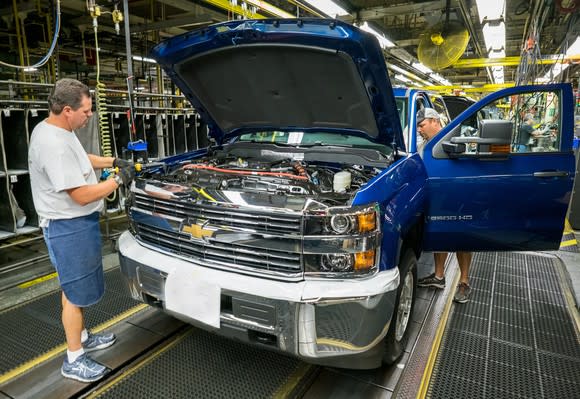Why the All-New 2019 Chevy Silverado Will Cost General Motors 60,000 Sales
Executives at General Motors (NYSE: GM) are clearly excited about the potential for their all-new full-size pickups, the 2019 Chevrolet Silverado and GMC Sierra.
Both are set to go into production late this year, and GM expects both to bring home more profits per truck than the current Silverado and Sierra.
But GM's chief financial officer, Chuck Stevens, recently made clear that the road from here to those fat profits would be a bumpy one, because putting these new pickups into production won't be simple.

Getting GM's all-new 2019 Chevrolet Silverado into production will be a complicated and expensive process. Image source: General Motors.
GM is learning from Ford's experience
While GM won't begin production of the new trucks until the fourth quarter of 2018, it has already begun making the extensive changes to its factories that will be required to build them.
GM is clearly hoping to learn from archrival Ford Motor Company's (NYSE: F) experience. The launch of Ford's all-new 2015 F-150 followed months of fevered work. That new F-150 had aluminum body panels instead of the steel panels of its predecessor, meaning that it required very different tooling and processes to build. Ford had to essentially gut and rebuild two of its busiest factories at a moment when pickup demand was booming.
Ford pulled it off, but not without a cost. The company warned beforehand that it would lose about 90,000 units of production. It had built up inventories of 2014-model-year pickups before beginning the factory conversions, but still: Ford's pickup sales lagged for several months while it worked to get the factories up and running again.
To be clear, that effort was worth the cost: Helped by a very strong market, the new F-150 helped carry Ford to record profits in 2015 and 2016. But here in 2018, the U.S. new-car market is looking a little ragged -- and so GM has come up with a plan that it hopes will improve somewhat on Ford's experience.
A big hit is coming in the first quarter
GM's new trucks don't have all-aluminum body panels. But as Stevens explained during GM's earnings call this week, the new trucks really are all-new, completely different from the current models. That means GM has to make extensive (and expensive) changes to major sections of its truck factories ("body shops" in company parlance) that assemble the truck's bodies and chassis.
This is an all-new architecture. Our last three generations of truck were fundamentally of the same architecture with changes in sheet metal. So this is an absolutely all-new architecture, which requires all-new body shops. So when we take downtime at certain facilities, it's because we're either converting or constructing new body shops to facilitate this launch. And we've been opportunistic around doing that around holiday periods so that you can get extra time to make these transitions without a full impact on downtime.
Those changes have already begun, and they're already having an impact. Stevens said that investors should expect a 60,000-unit decline in GM's shipments in North America in the first quarter, largely due to downtime at GM's pickup factories.
That's a big hit. To put it in perspective, while GM doesn't release exact production figures for every model, we know that it sold about 178,000 Silverados and Sierras combined in the U.S. in the first three months of 2017. GM is losing production equivalent to a third of its full-size-pickup sales in the first quarter of last year. Given the profitability of these trucks, that's a heavy hit.

Workers assemble a Chevrolet Silverado 2500 HD at GM's factory in Flint, Michigan, one of several GM factories that will be reworked to build all-new pickups. Image source: General Motors.
How GM will keep that number from getting worse
In total, Stevens said, GM expects to lose about 120,000 units of production in 2018 due to factory changes needed to make the all-new trucks. But there's a twist: GM has a complicated plan to boost production of its current trucks while some of its factories are retooled.
In a nutshell, GM's Fort Wayne Assembly Plant, in Roanoke, Indiana, will send partially assembled trucks and parts to its highly flexible Oshawa Assembly Plant, in Ontario, which will paint and finish the trucks. (Oshawa has an unused assembly line that is being converted to do this work.)
If that sounds a little bit Rube Goldberg, well, it is. It's a hack, one that GM has nicknamed the "Oshawa Shuttle." They hope the Shuttle will allow them get about 60,000 extra 2018-model pickups built this year. If it works, it will leave GM with a production decline of about 60,000.
That's not ideal, but it beats the 90,000 trucks that Ford lost in 2014 and 2015. More importantly, while GM will probably take a hit to its first-quarter results, it should be able to make up some of the lost profit by year-end.
More From The Motley Fool
John Rosevear owns shares of Ford and General Motors. The Motley Fool owns shares of and recommends Ford. The Motley Fool has a disclosure policy.
